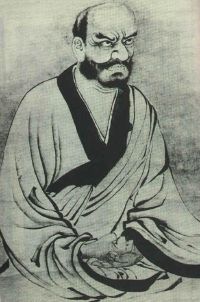Lin-chi
Línjì Yìxuán (臨済義玄; Wade-Giles: Lin-chi I-hsüan; Japanese: Rinzai Gigen) (?–866) was the founder of the Linji school of Chán Buddhism during Tang Dynasty China. Linji was born into a family named Xing in Caozhou (modern Heze in Shandong), which he left at a young age to study Buddhism in many places.
|
History of Buddhism | |
|
Timeline of Buddhism | |
|
Foundations | |
|
Four Noble Truths | |
|
Key Concepts | |
|
Three marks of existence | |
|
Major Figures | |
|
Gautama Buddha | |
|
Practices and Attainment | |
|
Buddhahood · Bodhisattva | |
|
Regions | |
|
Southeast Asia · East Asia | |
|
Branches | |
|
Theravāda · Mahāyāna | |
|
Texts | |
|
Pali Canon · Mahayana Sutras | |
|
Comparative Studies | |
Linji was trained by the Chan master Huángbò Xīyùn (黃蘗希運; Huang-Po Hsi-Yun) but, according to the Record of Linji, enlightened under the reclusive monk Dàyú (大愚). Linji's own teaching was greatly inspired by his master's, and was characterized by abrupt, harsh encounters with students, aiming to bring about the moment of enlightenment. His methods included shouting and striking, most often using the fly-whisk that was considered a symbol of a Zen master's authority:
"The Master [Linji] saw a monk coming and held his fly whisk straight up. The monk made a low bow, whereupon the Master struck him a blow. The Master saw another monk coming and again held his fly whisk straight up. The monk paid no attention, whereupon the Master struck him a blow as well."[1]
Linji also taught with lectures and sermons, which were collected by his students into the Línjì-lù (臨済錄; Japanese: Rinzai-roku), the Record of Linji. His lectures were a mixture of the conventional and the iconoclastic. He is particularly famous for encouraging his students to free themselves from the influence of masters and doctrinal concepts, in order to be able to better discover their own Buddha-nature. Famed examples of Linji's iconoclasm include the following:
Followers of the Way [of Zen], if you want to get the kind of understanding that accords with the Dharma, never be misled by others. Whether you're facing inward or facing outward, whatever you meet up with, just kill it! If you meet a buddha, kill the buddha. If you meet a patriarch, kill the patriarch. If you meet an arhat, kill the arhat. If you meet your parents, kill your parents. If you meet your kinfolk, kill your kinfolk. Then for the first time you will gain emancipation, will not be entangled with things, will pass freely anywhere you wish to go.[2]
Those who have fulfilled the ten stages of bodhisattva practice are no better than hired field hands; those who have attained the enlightenment of the fifty-first and fifty-second stages are prisoners shackled and bound; arhats and pratyekabuddhas are so much filth in the latrine; bodhi and nirvana are hitching posts for donkeys.[3]
In 851, Linji moved to the Linji temple in Hebei, where he took his name, which also became the name for the lineage of his form of Zen Buddhism. The Linji school ultimately became the most successful and widespread of the Five Houses of Chan.
The Japanese Rinzai school is a branch of the school Linji founded, as are the smaller Japanese Obaku school and the now-defunct Japanese Fuke school.
Notes
ReferencesISBN links support NWE through referral fees
- Keown, Damien. A Dictionary of Buddhism. Oxford: Oxford University Press, 2003. ISBN 0-19-860560-9.
- Lowenstein, Tom. The Vision of the Buddha: Buddhism – The Path to Spiritual Enlightenment. ISBN 1-903296-91-9.
- Watson, Burton; tr. The Zen Teachings of Master Lin-Chi: A Translation of the Lin-chi lu. New York: Columbia University Press, 1999. ISBN 0-231-11485-0.
External links
- Repository of translations of Linji
- The Record of Rinzai Complete Translation
Template:Buddhism2
cs:Lin-ťi de:Rinzai es:Rinzai Zen ja:臨済宗 pl:Lin Chi ru:Линьцзы vi:Lâm Tế Nghĩa Huyền
Credits
New World Encyclopedia writers and editors rewrote and completed the Wikipedia article in accordance with New World Encyclopedia standards. This article abides by terms of the Creative Commons CC-by-sa 3.0 License (CC-by-sa), which may be used and disseminated with proper attribution. Credit is due under the terms of this license that can reference both the New World Encyclopedia contributors and the selfless volunteer contributors of the Wikimedia Foundation. To cite this article click here for a list of acceptable citing formats.The history of earlier contributions by wikipedians is accessible to researchers here:
The history of this article since it was imported to New World Encyclopedia:
Note: Some restrictions may apply to use of individual images which are separately licensed.

